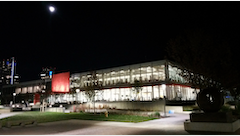Motivating Factors for the Transfer of Information Literacy Skills among Undergraduates
DOI:
https://doi.org/10.20343/teachlearninqu.10.17Keywords:
information literacy, motivation, first-year undergraduate students, educational psychologyAbstract
Faculty and academic librarians who provide information literacy (IL) instruction frequently puzzle over students’ inconsistent future use of IL skills. When they work with students who have received IL instruction in the past, some students demonstrate confident, mature, and practiced use of the skills. Others demonstrate skills that have either failed to develop further since the instruction session or skills that have atrophied. This study explores self-cited motivating factors for continued use of IL skills. It was conducted at an urban public research university in the United States, among 24 first- year undergraduates who participated in first-year seminars. The study connects the motivating factors with IL performance on a writing sample. It uses mixed methods involving a self-designed survey with Likert-style questions on eighteen motivating factors, plus a rubric adapted from the AAC&U VALUE rubrics.
Downloads
References
American Library Association. 1989. “Presidential Committee on Information Literacy: Final Report.” Association of College and Research Libraries. http://www.ala.org/acrl/publications/whitepapers/presidential.
Association of American Colleges and Universities (AACU). 2009. "Critical Thinking VALUE Rubric." https://www.aacu.org/value/rubrics/critical-thinking.
Association of American Colleges and Universities (AACU). 2013. "Information Literacy VALUE Rubric." https://www.aacu.org/value/rubrics/information-literacy.
Association of College and Research Libraries. 2016. “Framework for Information Literacy for Higher Education.” Chicago: Association of College and Research Libraries. http://www.ala.org/acrl/sites/ala.org.acrl/files/content/issues/infolit/Framework_ILIL.pdf.
Bankston, Sarah, Micah J. Waltz, and Heather K. Moberly. 2019. “Instructor-Librarian Collaboration to Improve Students’ Searching, Evaluation, and Use of Scientific Literature.” Association of College and Research Libraries: 153–62. https://oaktrust.library.tamu.edu/handle/1969.1/177537.
Beckford, Lilleth C. 2017. “Transferability: The Application of Information Literacy Competencies to Academic Area-of-Interest Course Research Paper among Adult College Students in an Undergraduate Liberal Arts Program.” PhD. Diss. St. John Fisher University. https://fisherpub.sjfc.edu/education_etd/327/.
Bransford, John, Ann L. Brown, Rodney R. Cocking (Eds.). 1999. How People Learn: Brain, Mind, Experience, and School. Washington, DC: National Academy Press.
Catalano, Amy. 2015. “The Effect of a Situated Learning Environment in a Distance Education Information Literacy Course.” Journal of Academic Librarianship 41 (5): 653–59. https://doi.org/10.1016/j.acalib.2015.06.008.
Deci, Edward L., and Richard M. Ryan. 1985. Intrinsic Motivation and Self-Determination in Human Behavior. New York: Plenum.
Deci, Edward L., and Richard M. Ryan. 2008. “Self-Determination Theory: A Macrotheory of Human Motivation, Development, and Health.” Canadian Psychology 49 (3): 182–85. https://doi.org/10.1037/a0012801.
Driscoll, Dana Lynn. 2014. “Clashing Values: A Longitudinal, Exploratory Study of Student Beliefs about General Education, Vocationalism, and Transfer of Learning.” Teaching & Learning Inquiry 2 (1): 21–37.
Eccles, Jacquelynne S. 1987. “Gender Roles and Women’s Achievement-Related Decisions.” Psychology of Women Quarterly 11: 135–72.
Eccles, Jacquelynne S., and Alan Wigfield. 2002. “Motivational Beliefs, Values, and Goals.” Annual Review of Psychology 53 (1): 109–32.
Hidi, Suzanne. 2006. “Interest: A Unique Motivational Variable.” Educational Research Review 1 (2): 69–82.
Kuglitsch, Rebecca Z. 2015. “Teaching for Transfer: Reconciling the Framework with Disciplinary Information Literacy.” Portal: Libraries and the Academy 15 (3): 457–70.
Lave, Jean. 1988. Cognition in Practice: Mind, Mathematics and Culture in Everyday Life. Cambridge, UK: Cambridge University Press.
Lobato, Joanne. 2006. “Alternative Perspectives on the Transfer of Learning: History, Issues, and Challenges for Future Research.” The Journal of the Learning Sciences 15 (4): 431–49.
Lobato, Joanne. 2012. “The Actor-Oriented Transfer Perspective and Its Contributions to Educational Research and Practice.” Educational Psychologist 47 (3): 232–47.
Lockwood, Elise. 2011. “Student Connections among Counting Problems: An Exploration Using Actor-Oriented Transfer.” Educational Studies in Mathematics 78 (3): 307–22.
Massenberg, Ann-Christine, Daniel Spurk, and Simone Kauffeld. 2015. “Social Support at the Workplace, Motivation to Transfer and Training Transfer: A Multilevel Indirect Effects Model.” International Journal of Training and Development 19 (3): 161–78.
McClurg, Caitlin, Margy MacMillan, and Nancy Chick. 2019. “Visions of the Possible: Engaging with Librarians in the Scholarship of Teaching and Learning.” Teaching & Learning Inquiry 7 (2): 3–13.
Ormrod, Jeanne Ellis. 2012. Human Learning. 6th ed. Boston: Pearson.
Patchen, Terri, and Dennis W. Smithenry. 2013. “Framing Science in a New Context: What Students Take Away from a Student-Directed Inquiry Curriculum.” Science Education 97 (6): 801–29.
Reid, Anna, Jennifer Rowley, and Dawn Bennett. 2019. “From Expert Student to Novice Professional: Higher Education and Sense of Self in the Creative and Performing Arts.” Music Education Research 21 (4), 399–413. https://doi.org/10.1080/14613808.2019.1632279.
Roorda, Gerrit. 2012. “Ontwikkeling in Verandering; Ontwikkeling van Wiskundige Bekwaamheid van Leerlingen met Betrekking tot Het Concept Afgeleide. [Development of ‘Change;’ the Development of Students’ Mathematical Proficiency With Respect to the Concept of Derivative.]” PhD. diss., Rijksuniversiteit Groningen [Netherlands].
Testers, Laurent, Andreas Gegenfurtner, and Saskia Brand-Gruwel. 2015. “Motivation to Transfer Learning to Multiple Contexts.” The School Library Rocks: Living It, Learning It, Loving It: 473–87.
University of Colorado Denver Institutional Research and Effectiveness. 2019. “Data on University of Colorado Denver First-year Students Enrolled in Fall 2018.” Organized using Tableau Public software 3 September 2019.” Denver Campus Fall 2018. Accessed 24 September 2020 https://public.tableau.com/profile/paula.dickson#!/vizhome/HeadcountEnrollmentDashboard-2018_2/Summary Note.
University of Colorado Denver Institutional Research and Effectiveness. 2019a. “Data on University of Colorado Denver Bachelor’s Degrees Awarded in 2018.” Organized using Tableau Public software 3 June 2019. Denver Campus All Degrees Over Time. https://public.tableau.com/profile/paula.dickson#!/vizhome/DegreesAwarded_29/Summary.
University of Colorado Denver Institutional Research and Effectiveness. 2019b. “Data on University of Colorado Denver First-year Students Enrolled in Spring 2019.” Organized using Tableau Public software 3 June 2019. Denver Campus spring 2019 - census. Retrieved from https://public.tableau.com/profile/paula.dickson#!/vizhome/HeadcountEnrollmentDashboard-2018_2/Summary.

Downloads
Published
How to Cite
Issue
Section
License
Copyright (c) 2022 Karen Sobel

This work is licensed under a Creative Commons Attribution-NonCommercial 4.0 International License.


